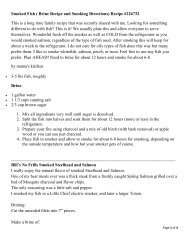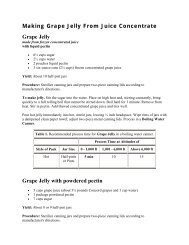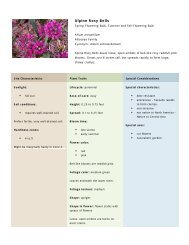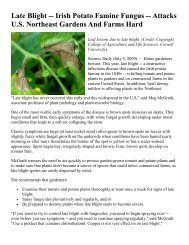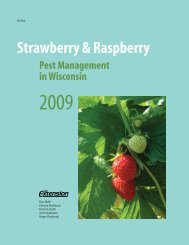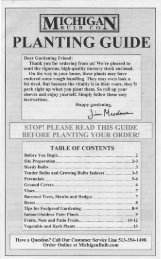Growing Blackberries in Your Home Garden, EC 1303 (Oregon ...
Growing Blackberries in Your Home Garden, EC 1303 (Oregon ...
Growing Blackberries in Your Home Garden, EC 1303 (Oregon ...
- No tags were found...
Create successful ePaper yourself
Turn your PDF publications into a flip-book with our unique Google optimized e-Paper software.
<strong>EC</strong> <strong>1303</strong>—Revised March 2008 u $1.50Gr o w i ng Bl ac k b e r r i e s<strong>in</strong> Yo u r Ho m e Ga r d e nB.C. Strik<strong>Oregon</strong> is known around the world for itsblackberries. We have an ideal climate, withwarm, clear, summer days and cool nights, so ourberries reach peak flavor and quality. We also growexcellent black and red raspberries (see <strong>EC</strong> 1306,<strong>Grow<strong>in</strong>g</strong> Raspberries <strong>in</strong> <strong>Your</strong> <strong>Home</strong> <strong>Garden</strong>).<strong>Blackberries</strong> are dist<strong>in</strong>guished from raspberries bywhether the fruit reta<strong>in</strong>s its receptacle (white core)when picked. In blackberries, the receptacle stayswith the fruit; <strong>in</strong> raspberries, it stays with the plant.This publication briefly describes the grow<strong>in</strong>grequirements and production systems for blackberries.Differences among types are <strong>in</strong>dicated asappropriate.Types of blackberriesThere are three ma<strong>in</strong> types of blackberry:trail<strong>in</strong>g, erect, and semierect. The primarydifference is the growth habit of their canes.Trail<strong>in</strong>g blackberry cultivars <strong>in</strong>clude‘Marion’(“marionberry”), ‘Cascade’, ‘Santiam’,‘Black Butte’, ‘Obsidian’, ‘Thornless Evergreen’,and ‘Olallie’ (“olallieberry”). The fruit quality isconsidered excellent, with very good aroma andsmall seeds. The fruit<strong>in</strong>g season ranges from mid-June to early September, depend<strong>in</strong>g on cultivar.Trail<strong>in</strong>g blackberries are considered the leastcold-hardy of the three types of blackberries.Expect damage to buds and canes when temperaturesdrop below about 13ºF <strong>in</strong> December or earlyJanuary. Plants are more sensitive to cold <strong>in</strong> latefall and late w<strong>in</strong>ter, when damage might occur atObsidian.much warmer temperatures (<strong>in</strong> the 20sºF). Trail<strong>in</strong>gblackberries grow well west of the Cascades <strong>in</strong><strong>Oregon</strong> and southern Wash<strong>in</strong>gton, although somedamage might occur <strong>in</strong> particularly cold w<strong>in</strong>ters.You can grow trail<strong>in</strong>g types <strong>in</strong> colder areas withlow w<strong>in</strong>ter ra<strong>in</strong>fall if you leave the canes on theground and mulch them <strong>in</strong> w<strong>in</strong>ter.Several hybrids between raspberry and trail<strong>in</strong>gblackberry have been developed, <strong>in</strong>clud<strong>in</strong>g‘Logan’, ‘Tayberry’, and ‘Boysen’ (“boysenberry”).S<strong>in</strong>ce these grow and are managed like atrail<strong>in</strong>g blackberry, they usually are <strong>in</strong>cluded withthis group.Erect blackberries produce stiff, erect canesthat need summer and w<strong>in</strong>ter prun<strong>in</strong>g. Cultivars<strong>in</strong>clude ‘Cherokee’, ‘Shawnee’, and ‘Navaho’.Fruit are glossy and firm, with a milder aroma andflavor and larger seeds than the trail<strong>in</strong>g types.Bernad<strong>in</strong>e C. Strik, Extension berry crops professor,<strong>Oregon</strong> State University
The fruit<strong>in</strong>g season extends from early July tofrost, depend<strong>in</strong>g on the variety.Semierect blackberries produce very vigorous,thick, arch<strong>in</strong>g canes that benefit from summerand w<strong>in</strong>ter prun<strong>in</strong>g. Cultivars <strong>in</strong>clude ‘TripleCrown’, ‘Loch Ness’, and ‘Chester Thornless’.For detailed <strong>in</strong>formation on the cultivars with<strong>in</strong>each type, see Blackberry Cultivars for <strong>Oregon</strong>,<strong>EC</strong> 1617.Growth and fruit<strong>in</strong>g cycleAll blackberry plants are perennial; the rootsand the base of the plant (crown) live for manyyears. The canes are biennial; they grow 1 year(primocanes), produce fruit the follow<strong>in</strong>g year(floricanes), and die after harvest. All types ofblackberries produce new canes each year fromthe crown, and erect types also produce new canesfrom the roots. Dur<strong>in</strong>g the grow<strong>in</strong>g season, bothnew vegetative primocanes (which will fruit nextyear) and fruit<strong>in</strong>g floricanes (which will die <strong>in</strong> thew<strong>in</strong>ter) are present.After harvest, the floricanes are removed, andthe primocanes, which will fruit the follow<strong>in</strong>gyear, are tra<strong>in</strong>ed. In some types of blackberries, theprimocanes are also pruned.Primocane-fruit<strong>in</strong>g (sometimes called “fallfruit<strong>in</strong>g” or “everbear<strong>in</strong>g”) blackberries are anexception to this fruit<strong>in</strong>g pattern. This type of erectblackberry is the only k<strong>in</strong>d that produces flowersand fruit on the current-season primocanes. Thefruit<strong>in</strong>g season is from late August to the first fallfrost.Blackberry canesThere are two names for a blackberry cane,depend<strong>in</strong>g on whether the cane is <strong>in</strong> its first orsecond year of growth.Primocanes: first year of growth; most typesproduce no fruit on these canes.Floricanes: second year of growth; these canesproduce flowers and fruit and then die.Select<strong>in</strong>g a site<strong>Blackberries</strong> produce best <strong>in</strong> full sun, but theytolerate partial shade.<strong>Blackberries</strong> are more tolerant to heavy soilsthan any other berry crop. However, it’s best toselect a site with good dra<strong>in</strong>age. Plants grow best<strong>in</strong> a well-dra<strong>in</strong>ed, fertile, loam soil with moderatewater-hold<strong>in</strong>g capacity.Select<strong>in</strong>g a cultivarThe various types of blackberries require differentcare, and cultivars differ greatly <strong>in</strong> fruit<strong>in</strong>gseason, fruit and seed size, appearance, and flavor.All types are self-fruitful, so you need only onecultivar for poll<strong>in</strong>ation and fruit production. Forcultivar descriptions, see Blackberry Cultivars for<strong>Oregon</strong>, <strong>EC</strong> 1617.Establish<strong>in</strong>g your plant<strong>in</strong>gPrepar<strong>in</strong>g the soilYou should be able to keep your blackberryplant<strong>in</strong>g productive for 15 to 20 years, so chooseand prepare a site carefully.Elim<strong>in</strong>ate all perennial weeds. Prevent weedsfrom go<strong>in</strong>g to seed!Almost any soil type is suitable for blackberriesas long as the dra<strong>in</strong>age is good. <strong>Blackberries</strong>grow best when the soil pH is between 5.5 and 7.Test soil pH the year before you plant. (For more<strong>in</strong>formation about soil test<strong>in</strong>g, see LaboratoriesServ<strong>in</strong>g <strong>Oregon</strong>: Soil, Water, Plant Tissue, andFeed Analysis, EM 8677, and Soil Sampl<strong>in</strong>g for<strong>Home</strong> <strong>Garden</strong>s and Small Acreages, <strong>EC</strong> 628.) Ifthe soil is too acidic (pH below 5.5), add lime tothe soil as recommended by the soil analysis.A good supply of soil organic matter improvesaeration and dra<strong>in</strong>age and <strong>in</strong>creases water-hold<strong>in</strong>gcapacity. Apply organic matter the summer or fallbefore you plant. Manure is a good source. Useabout 2 cu yd per 100 sq ft of plant<strong>in</strong>g area. Youalso can use decomposed (rotted) compost. Useonly materials that you th<strong>in</strong>k are free from <strong>in</strong>sectsand weed seeds.2
Black Diamond.Dig, plow, or rototill the material <strong>in</strong>to thesoil to ensure that it will be well decomposed byplant<strong>in</strong>g time. If you <strong>in</strong>corporate large amounts ofnondecomposed material <strong>in</strong>to the soil, add2 lb calcium nitrate (16 percent nitrogen) per100 sq ft to aid <strong>in</strong> decomposition.If your garden is slow to dra<strong>in</strong>, or if the watertable is high, you can <strong>in</strong>stall a dra<strong>in</strong> tile near therow (at least 25 <strong>in</strong>ches deep) or plant on raisedbeds.Spac<strong>in</strong>gFor trail<strong>in</strong>g cultivars, space plants 4 to 6 feetapart <strong>in</strong> the rows. Space erect cultivars 2 to 3 feetapart and semierect cultivars 5 to 6 feet apart.Leave about 10 feet between rows.Plant<strong>in</strong>gIt’s best to purchase certified disease-freeplants from a nursery. Plants from a neighbor’splant<strong>in</strong>g could <strong>in</strong>troduce root-rot organisms,viruses, or other pests <strong>in</strong>to your garden. Traditionally,plants were sold as fairly large “bare-root”plants, but tissue-cultured plants are becom<strong>in</strong>gmore common. These plants are lush and tenderand are sold <strong>in</strong> small cell packs.If you can’t plant immediately, bury plant roots<strong>in</strong> moist soil or sawdust to prevent dry<strong>in</strong>g.To propagate cultivars that produce suckers,simply transplant rooted suckers. Propagate trail<strong>in</strong>gcultivars, which produce fewer root suckers,by tip layer<strong>in</strong>g. Cover tips of canes with soil <strong>in</strong> thelate summer or early fall. Cut rooted tips from thecanes and transplant them the follow<strong>in</strong>g spr<strong>in</strong>g.Plant as early as you can work the soil <strong>in</strong>the spr<strong>in</strong>g. Dig a shallow hole, large enough toaccommodate the roots. If you have bare-rootplants, spread the root mass and set the plant sothat the highest po<strong>in</strong>t of attachment of roots tocane is 1 to 1 1 ⁄2 <strong>in</strong>ches below ground level. Coverwith soil and press firmly to remove air pockets.Water the plants to settle the soil. Cut the canes onnewly set bare-root plants to 6 <strong>in</strong>ches at plant<strong>in</strong>gtime. Tissue-cultured plants need more care afterplant<strong>in</strong>g and should be treated like a vegetabletransplant; plant them at about the same depth asthe conta<strong>in</strong>er (or slightly deeper) and water themfrequently until established.TrellisIt’s advisable to trellis all blackberries. Youcan grow erect blackberries without support, buttrellises help prevent cane breakage from w<strong>in</strong>d,keep the plant<strong>in</strong>g neater, and make cultivation andharvest<strong>in</strong>g easier.Trail<strong>in</strong>g blackberries. This type of blackberryis easy to grow on a simple two-wire trellis. Use8-foot or longer wooden end posts. Bury one endof each post, leav<strong>in</strong>g 6 feet above ground. Placemetal posts every 20 feet <strong>in</strong> the row. Run a topwire almost 6 feet above ground and a lower wire4 1 ⁄2 feet above ground (Figure 1). Use high- tensilewire and <strong>in</strong>stall tighten<strong>in</strong>g devices at one end ofthe row. In the plant<strong>in</strong>g year, tra<strong>in</strong> new primocanes18"4.5 to 6'B20 to 30' between postsAFigure 1. Two-wire trellis for trail<strong>in</strong>g blackberries, <strong>in</strong>the grow<strong>in</strong>g season (leaves and fruit<strong>in</strong>g laterals notdrawn for clarity): (A) Floricanes that just bore fruit andwill die. (B) Wire guide for new cane growth. (C) Newprimocane growth that will bear fruit the follow<strong>in</strong>g year.C3
as they grow. Bundle the canes and use tw<strong>in</strong>e totra<strong>in</strong> them straight up to the top wire. If canesgrow longer than the top wire, start wrapp<strong>in</strong>g themcarefully around the two tra<strong>in</strong><strong>in</strong>g wires, spread<strong>in</strong>gout canes (Figure 1, page 3, and Figure 2). Thesecanes will fruit next year.Tra<strong>in</strong><strong>in</strong>g the canes to a multiple-wire trellis(Figure 3) or an exist<strong>in</strong>g fence is another option,but tra<strong>in</strong><strong>in</strong>g is more difficult with these methods.Erect blackberries. Erect blackberries produceshort, stiff canes from both the crown andthe roots, thus form<strong>in</strong>g a hedgerow. A simpleknee-high “T” trellis with a 1 1 ⁄2-foot-wide top willsupport the canes. You can make this type of trelliswith rebar. Str<strong>in</strong>g tw<strong>in</strong>e or wire down each sideof the row. Erect blackberries can be tra<strong>in</strong>ed tothe trellis used for trail<strong>in</strong>g blackberries if you aregrow<strong>in</strong>g both types.Semierect blackberries. These plants arevigorous and are easiest to manage on a “doubleT” trellis. Use sturdy end posts, and bury one endso that 6 feet rema<strong>in</strong>s above ground. Use 2x4s forcross arms. Install one cross arm at the top of thepost; this cross arm should be about 4 feet long.Install a 3-foot-wide cross arm about 2 feet belowthe top one. Run high-tensile wire along the rowon each side of the cross arms; you’ll have fourwires.Fertiliz<strong>in</strong>gIn the plant<strong>in</strong>g year, fertilize each plant with½ to 1 oz nitrogen (N), depend<strong>in</strong>g on soil fertility.Use a well-balanced fertilizer such as 16-16-16. Tocalculate how much product to apply, divide thedesired amount of N you need to apply (for example,1 oz) by the percentage of N <strong>in</strong> the fertilizer:1 ÷ 0.16 = 6.3 oz of fertilizer per plant.Do not apply all of the fertilizer at once.Divide the total <strong>in</strong>to thirds and apply the first onethird2 weeks after plant<strong>in</strong>g, the next one-third1 month later, and the f<strong>in</strong>al one-third 1 month afterthe second application. In the above example, youwould apply 2.1 oz of 16-16-16 per applicationper plant (6.3 ÷ 3 = 2.1). Distribute the fertilizerevenly <strong>in</strong> a small area around the young plants.Irrigation and weed controlSupplement ra<strong>in</strong>fall with irrigation as neededto supply about 1 <strong>in</strong>ch of water a week. Keep thearea around plants free of weeds.No fruit is produced <strong>in</strong> the plant<strong>in</strong>g year.A12"12"12"24 to 36"BCFigure 2. Marion blackberry tra<strong>in</strong>ed <strong>in</strong> August. Picturetaken <strong>in</strong> February.Figure 3. Multiple-wire trellis for trail<strong>in</strong>g blackberries, <strong>in</strong>the grow<strong>in</strong>g season (leaves not drawn for clarity): (A)Canes that just bore fruit and will die. (B) Wire guide fornew cane growth. (C) New growth that will bear fruit thefollow<strong>in</strong>g year.4
How much should I fertilize?A good guide for fertilization is to observeplant growth. Primocane leaves should be ahealthy green; a pale green or yellow colormay <strong>in</strong>dicate nitrogen deficiency. Canesshould grow well.Care of establishedplant<strong>in</strong>gsFertiliz<strong>in</strong>gAfter the plant<strong>in</strong>g year, apply fertilizer annuallyto ma<strong>in</strong>ta<strong>in</strong> good growth and leaf color.Apply from 1 to 1 1 ⁄2 oz N per plant (6.3 to 9.5 oz16-16-16 per plant) per year. Divide the total <strong>in</strong>tothirds, and apply one-third at each of three times:(1) when the new primocanes start to grow,(2) at the end of May, and (3) at the end of June.Spread fertilizer over the entire surface of the soil<strong>in</strong> the row. Irrigate right after fertiliz<strong>in</strong>g.If you use manure, apply it <strong>in</strong> late fall orearly w<strong>in</strong>ter to a depth of 2 to 3 <strong>in</strong>ches <strong>in</strong> the row.Reduce the rate of nitrogen fertilizer applied byone-half. Manure applied early <strong>in</strong> the fall maycause blackberries to grow late <strong>in</strong> the season, mak<strong>in</strong>gthem more susceptible to w<strong>in</strong>ter <strong>in</strong>jury.If you use organic mulches for weed control,you may need to apply additional nitrogen fertilizerto assist <strong>in</strong> breakdown of the mulch.IrrigationEstablished blackberry plants need 1 to1 1 ⁄2 <strong>in</strong>ches of water per week from mid-Junethrough late summer. Irrigate when ra<strong>in</strong>fall doesn’tprovide this amount. Plants need more water <strong>in</strong>extremely warm and w<strong>in</strong>dy conditions. To avoidexcessive disease to canes or fruit, it is best to usedrip irrigation or under-canopy spr<strong>in</strong>klers.Weed managementCultivate to control weeds. Cultivate no deeperthan 1 to 2 <strong>in</strong>ches to prevent root damage. You canuse a mulch or landscape cloth (weed mat) aroundtrail<strong>in</strong>g and semierect blackberries to controlweeds. Weed mat is not recommended for erecttypes as it will prevent primocane emergence fromroots.Prun<strong>in</strong>g and tra<strong>in</strong><strong>in</strong>gPrun<strong>in</strong>g <strong>in</strong>structions vary by the type ofblackberry.Trail<strong>in</strong>g blackberryTrail<strong>in</strong>g blackberries produce new primocanes<strong>in</strong> the spr<strong>in</strong>g at the crown of the plant. (No rootsuckers are produced.) After grow<strong>in</strong>g upright for ashort time, these canes turn down and grow alongthe ground.After the first year, there will be fruit<strong>in</strong>g caneson the wire, while new primocanes will grow fromthe crown start<strong>in</strong>g <strong>in</strong> spr<strong>in</strong>g. To avoid damage tonew primocanes, keep them tra<strong>in</strong>ed <strong>in</strong> a narrowrow beneath the bear<strong>in</strong>g canes (Figure 1, page 3).If you have more than one plant, tra<strong>in</strong> all theprimocanes <strong>in</strong> one direction down the row (ratherthan what is shown <strong>in</strong> Figure 1). This will helpprevent primocanes from tangl<strong>in</strong>g and make tra<strong>in</strong><strong>in</strong>geasier. Do not summer prune or tip primocanesdur<strong>in</strong>g the grow<strong>in</strong>g season.After fruit harvest, the floricanes start to die.Unless there is a lot of cane disease, it’s best todelay cutt<strong>in</strong>g off the canes as long as possible.This allows the dy<strong>in</strong>g canes to move nutrients back<strong>in</strong>to the crown and roots, mak<strong>in</strong>g for a healthierplant.In western <strong>Oregon</strong>, it’s best to tra<strong>in</strong> the newprimocanes on the trellis <strong>in</strong> late August. The riskof cold <strong>in</strong>jury <strong>in</strong>creases if you wait to tra<strong>in</strong> <strong>in</strong>September through fall. In eastern <strong>Oregon</strong> andWash<strong>in</strong>gton, leave the primocanes on the ground.In areas with frequent low w<strong>in</strong>ter temperatures,you can try to protect the canes through the w<strong>in</strong>terwith a straw mulch. Then tra<strong>in</strong> the primocanesonto the trellis <strong>in</strong> late February, after any danger ofsevere cold has passed. Tra<strong>in</strong><strong>in</strong>g canes dur<strong>in</strong>g coldtemperatures is not advised, as brittle canes breakeasily.5
Figure 4. Marion blackberry just before fruit harvest season show<strong>in</strong>g new primocane tra<strong>in</strong><strong>in</strong>g technique.To tra<strong>in</strong> primocanes, wrap them, one or two ata time, <strong>in</strong> a spiral around the trellis wires, work<strong>in</strong>geach way from the plant (Figure 1). The canesfrom adjacent plants should overlap as little aspossible on the trellis (Figure 4). Plants may alsobe tra<strong>in</strong>ed as shown <strong>in</strong> Figure 3 (page 4). Wraplong branches around the ma<strong>in</strong> canes. No w<strong>in</strong>terprun<strong>in</strong>g of primocanes is necessary.Erect blackberryErect cultivars require little prun<strong>in</strong>g dur<strong>in</strong>gthe plant<strong>in</strong>g year. Don’t be surprised if canes trailalong the ground a bit the first year.These blackberries require summer prun<strong>in</strong>g.Early <strong>in</strong> the summer, remove the top 1 to 2 <strong>in</strong>chesof new primocanes when they are about 4 feettall. This causes the canes to branch, and thesebranches will produce fruit the next year. Checkthe plant<strong>in</strong>g several times to make sure you pruneall of the primocanes as they grow.Primocanes (“suckers”) that grow outside thehedgerow are weeds. Remove them as soon as yousee them.In w<strong>in</strong>ter (December–February), remove thedead floricanes that fruited last season. In latew<strong>in</strong>ter, shorten the lateral branches to about 1 1 ⁄2 to2 1 ⁄2 feet long.Primocane-fruit<strong>in</strong>g erect blackberries. Thistype of blackberry produces new primocanes fromthe crown and buds on the roots. Primocanes willflower and fruit <strong>in</strong> the current season. If left tooverw<strong>in</strong>ter, the portion of the primocane that didnot fruit will become a floricane and will flowerand fruit the follow<strong>in</strong>g summer. Thus, this type ofblackberry can produce two crops per year. Thefirst, <strong>in</strong> July, is produced on the floricanes; the second,from early September until frost, is producedon the new primocanes.However, if you have enough space togrow two types of blackberries, grow aObsidian.6
primocane-fruiter for only the primocane crop.If you want fruit <strong>in</strong> July, it is best to grow afloricane-fruit<strong>in</strong>g erect (e.g., ‘Navaho’) or trail<strong>in</strong>gblackberry (e.g., ‘Marion’ or ‘Boysen’). Thesetypes produce better quality fruit and a higheryield than the floricane crop of primocane-fruit<strong>in</strong>gblackberries.To grow primocane-fruit<strong>in</strong>g blackberries foronly a primocane crop, cut all the canes off to justabove ground level <strong>in</strong> late w<strong>in</strong>ter. When the newprimocanes are 3 1 ⁄2 feet tall, remove about 6 <strong>in</strong>chesof the tip. The branches produced will flower andfruit <strong>in</strong> the fall. A summer-pruned primocane willproduce more than three times the yield of anuntipped primocane.Canes may benefit from a temporary trellis.Semierect blackberriesSemierect blackberries also require summerprun<strong>in</strong>g. When primocanes are just over 5 feet tall,remove the top 2 <strong>in</strong>ches of the tip to encourage theproduction of lateral branches. Check the plant<strong>in</strong>gseveral times, and tip all of the primocanes as theygrow.In w<strong>in</strong>ter, first remove the dead floricanes.Tra<strong>in</strong> the rema<strong>in</strong><strong>in</strong>g primocanes to the double “T”trellis (Figure 5). The branches do not need to beshortened. However, if they are too vigorous andare difficult to tra<strong>in</strong>, they can be shortened <strong>in</strong> latew<strong>in</strong>ter.HarvestPick berries every 4 to 7 days, depend<strong>in</strong>g onweather and cultivar. Regular pick<strong>in</strong>g m<strong>in</strong>imizesproblems with disease and <strong>in</strong>sect pests that likeoverripe, rott<strong>in</strong>g fruit. When the berries are ripe,you can pick them quite easily. Use a break<strong>in</strong>g,rather than pull<strong>in</strong>g, motion. Pick <strong>in</strong>to a shallowconta<strong>in</strong>er to prevent fruit from crush<strong>in</strong>g.To extend shelf life, avoid pick<strong>in</strong>g when berriesare wet, and refrigerate as soon as possible.Expect yields of 10 to 13 lb/plant <strong>in</strong> trail<strong>in</strong>gblackberry cultivars, 4 to 6 lb/plant <strong>in</strong> erect types,and 25 to 55 lb/plant <strong>in</strong> semierect types.Boysen.Figure 5. Semierect blackberry (‘Chester’) tra<strong>in</strong>ed to adouble “T” trellis.7
Pests and other problemsThe most common disease problems <strong>in</strong>cludecane and leaf spot, yellow rust, anthracnose, andfruit rot. The most important <strong>in</strong>sect problem is redberry mite. Photos and suggested control measuresfor these pests can be found on the Internet(http://berrygrape.oregonstate.edu/; http://pnwpest.org/pnw/<strong>in</strong>sects). Many of these problems canbe controlled with dormant and delayed dormantapplications of lime sulfur and oil.Cold <strong>in</strong>jury can cause crop loss. Trail<strong>in</strong>g blackberriesare the most sensitive to cold. Hot summertemperatures can cause fruit sunburn (ultravioletlight damage), which causes white drupelets.For more <strong>in</strong>formationBlackberry Cultivars for <strong>Oregon</strong>, C. F<strong>in</strong>n andB.C. Strik, <strong>EC</strong> 1617.<strong>Grow<strong>in</strong>g</strong> Raspberries <strong>in</strong> <strong>Your</strong> <strong>Home</strong> <strong>Garden</strong>,B.C. Strik, <strong>EC</strong> 1306.Laboratories Serv<strong>in</strong>g <strong>Oregon</strong>: Soil, Water, PlantTissue, and Feed Analysis, J. Hart, EM 8677.Soil Sampl<strong>in</strong>g for <strong>Home</strong> <strong>Garden</strong>s and SmallAcreages, M. Robotham and J. Hart, <strong>EC</strong> 628.Many OSU Extension Service publicationsmay be viewed or downloaded from the Web.Visit the onl<strong>in</strong>e Publications and Videos catalog athttp://eesc.oregonstate.edu/catalogCopies of our publications and videos also areavailable from OSU Extension and ExperimentStation Communications. For prices and order<strong>in</strong>g<strong>in</strong>formation, visit our onl<strong>in</strong>e catalog or contactus by fax (541-737-0817), e-mail (puborders@oregonstate.edu), or phone (541-737-2513).Blackberry or raspberry?It’s easy to tell a blackberry from araspberry. In a raspberry (left), the fruitreceptacle (core of the berry) rema<strong>in</strong>s onthe plant when you pick the fruit, leav<strong>in</strong>g anopen<strong>in</strong>g <strong>in</strong> the fruit. In a blackberry (right),the receptacle is part of the fruit that you eat;the fruit has no open<strong>in</strong>g.© 2008 <strong>Oregon</strong> State UniversityTrade‐name cultivars are listed as illustrations only. The OSU Extension Service does not endorse any listed cultivar or <strong>in</strong>tend any discrim<strong>in</strong>ation aga<strong>in</strong>st othersnot listed.This publication was produced and distributed <strong>in</strong> furtherance of the Acts of Congress of May 8 and June 30, 1914. Extension work is a cooperative program of<strong>Oregon</strong> State University, the U.S. Department of Agriculture, and <strong>Oregon</strong> counties. <strong>Oregon</strong> State University Extension Service offers educational programs,activities, and materials without discrim<strong>in</strong>ation based on age, color, disability, gender identity or expression, marital status, national orig<strong>in</strong>, race, religion, sex,sexual orientation, or veteran’s status. <strong>Oregon</strong> State University Extension Service is an Equal Opportunity Employer.Published July 1989. Revised March 2008.




